Financial Institution Risk Management: Interest & Exchange Rate Risks
VerifiedAdded on 2023/06/11
|14
|4492
|213
Report
AI Summary
This report provides an analysis of the nature of market risks faced by banks and how these risks are managed. It begins by defining market risk as the potential for losses in a bank's trading books due to changes in various market indicators, distinguishing between systematic and unsystematic risk. The report then delves into specific market risks, focusing on interest rate risk and foreign exchange rate risk. For interest rate risk, it explains how fluctuations in interest rates can negatively affect a bank's net worth and earnings, detailing measurement techniques like gap analysis and response strategies such as asset/liability management, financial derivatives, and hedging. Regarding foreign exchange rate risk, the report discusses the factors influencing foreign exchange rates and the different types of exposure banks face, including transaction, economic, translation, and contingent exposure, further elaborating on mitigation techniques such as matching foreign currency assets and liabilities, using derivatives, and diversifying foreign asset-liability portfolios. The report concludes by highlighting the importance of capital regulations in mitigating market risk, allowing banks to operate within the derivatives market while maintaining regulatory capital minimums. This document is available on Desklib, a platform offering study tools and resources for students.
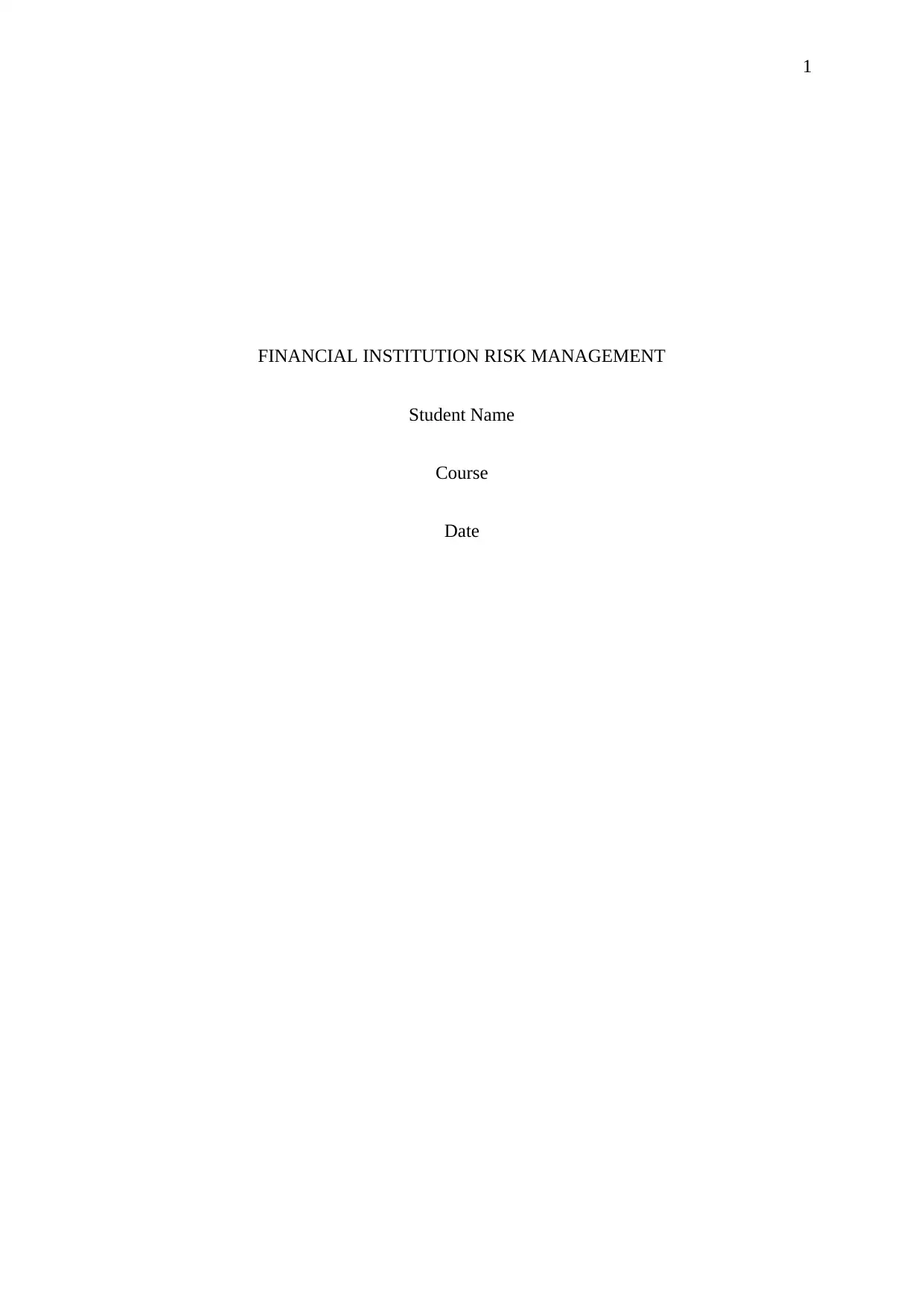
1
FINANCIAL INSTITUTION RISK MANAGEMENT
Student Name
Course
Date
FINANCIAL INSTITUTION RISK MANAGEMENT
Student Name
Course
Date
Paraphrase This Document
Need a fresh take? Get an instant paraphrase of this document with our AI Paraphraser
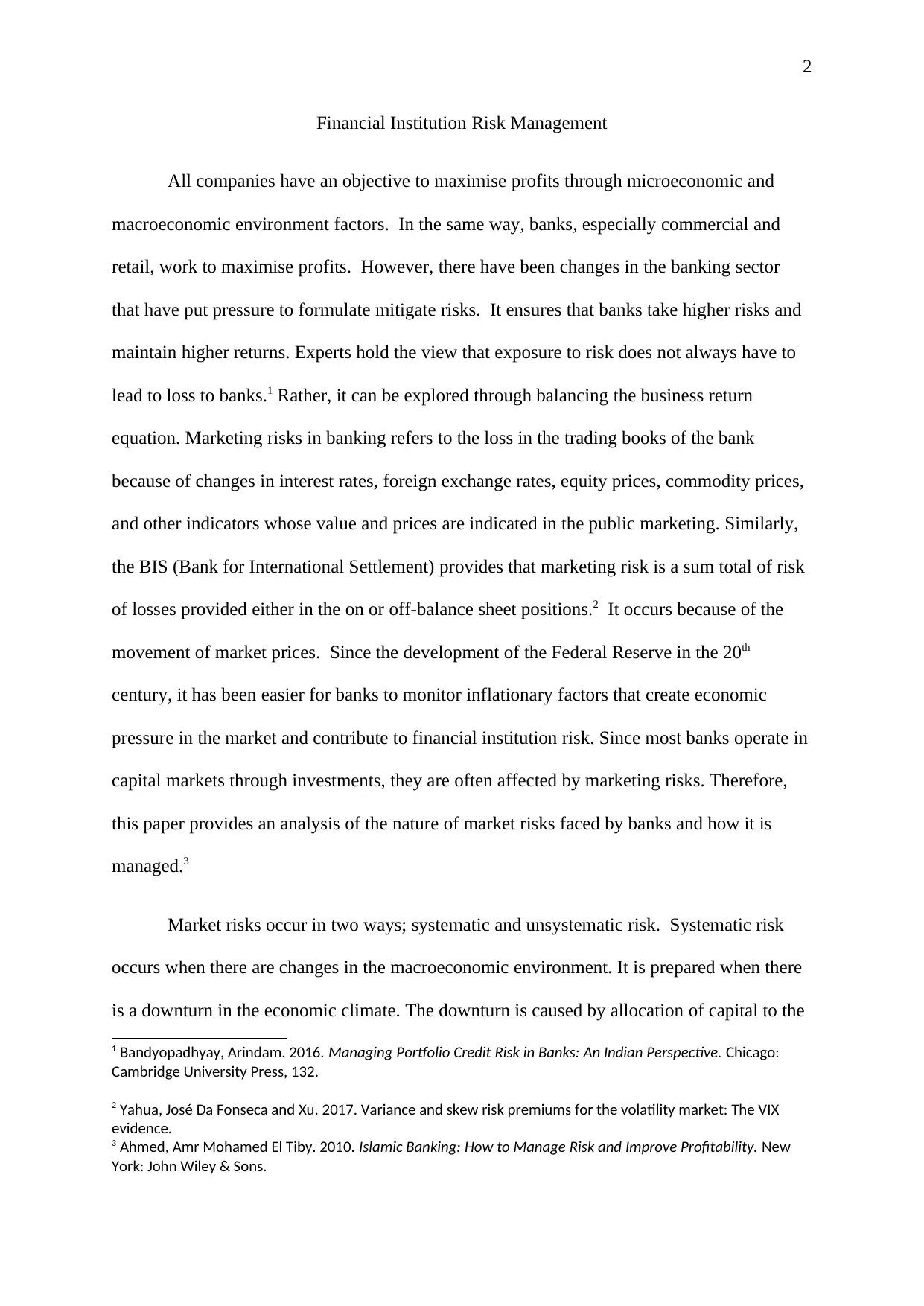
2
Financial Institution Risk Management
All companies have an objective to maximise profits through microeconomic and
macroeconomic environment factors. In the same way, banks, especially commercial and
retail, work to maximise profits. However, there have been changes in the banking sector
that have put pressure to formulate mitigate risks. It ensures that banks take higher risks and
maintain higher returns. Experts hold the view that exposure to risk does not always have to
lead to loss to banks.1 Rather, it can be explored through balancing the business return
equation. Marketing risks in banking refers to the loss in the trading books of the bank
because of changes in interest rates, foreign exchange rates, equity prices, commodity prices,
and other indicators whose value and prices are indicated in the public marketing. Similarly,
the BIS (Bank for International Settlement) provides that marketing risk is a sum total of risk
of losses provided either in the on or off-balance sheet positions.2 It occurs because of the
movement of market prices. Since the development of the Federal Reserve in the 20th
century, it has been easier for banks to monitor inflationary factors that create economic
pressure in the market and contribute to financial institution risk. Since most banks operate in
capital markets through investments, they are often affected by marketing risks. Therefore,
this paper provides an analysis of the nature of market risks faced by banks and how it is
managed.3
Market risks occur in two ways; systematic and unsystematic risk. Systematic risk
occurs when there are changes in the macroeconomic environment. It is prepared when there
is a downturn in the economic climate. The downturn is caused by allocation of capital to the
1 Bandyopadhyay, Arindam. 2016. Managing Portfolio Credit Risk in Banks: An Indian Perspective. Chicago:
Cambridge University Press, 132.
2 Yahua, José Da Fonseca and Xu. 2017. Variance and skew risk premiums for the volatility market: The VIX
evidence.
3 Ahmed, Amr Mohamed El Tiby. 2010. Islamic Banking: How to Manage Risk and Improve Profitability. New
York: John Wiley & Sons.
Financial Institution Risk Management
All companies have an objective to maximise profits through microeconomic and
macroeconomic environment factors. In the same way, banks, especially commercial and
retail, work to maximise profits. However, there have been changes in the banking sector
that have put pressure to formulate mitigate risks. It ensures that banks take higher risks and
maintain higher returns. Experts hold the view that exposure to risk does not always have to
lead to loss to banks.1 Rather, it can be explored through balancing the business return
equation. Marketing risks in banking refers to the loss in the trading books of the bank
because of changes in interest rates, foreign exchange rates, equity prices, commodity prices,
and other indicators whose value and prices are indicated in the public marketing. Similarly,
the BIS (Bank for International Settlement) provides that marketing risk is a sum total of risk
of losses provided either in the on or off-balance sheet positions.2 It occurs because of the
movement of market prices. Since the development of the Federal Reserve in the 20th
century, it has been easier for banks to monitor inflationary factors that create economic
pressure in the market and contribute to financial institution risk. Since most banks operate in
capital markets through investments, they are often affected by marketing risks. Therefore,
this paper provides an analysis of the nature of market risks faced by banks and how it is
managed.3
Market risks occur in two ways; systematic and unsystematic risk. Systematic risk
occurs when there are changes in the macroeconomic environment. It is prepared when there
is a downturn in the economic climate. The downturn is caused by allocation of capital to the
1 Bandyopadhyay, Arindam. 2016. Managing Portfolio Credit Risk in Banks: An Indian Perspective. Chicago:
Cambridge University Press, 132.
2 Yahua, José Da Fonseca and Xu. 2017. Variance and skew risk premiums for the volatility market: The VIX
evidence.
3 Ahmed, Amr Mohamed El Tiby. 2010. Islamic Banking: How to Manage Risk and Improve Profitability. New
York: John Wiley & Sons.
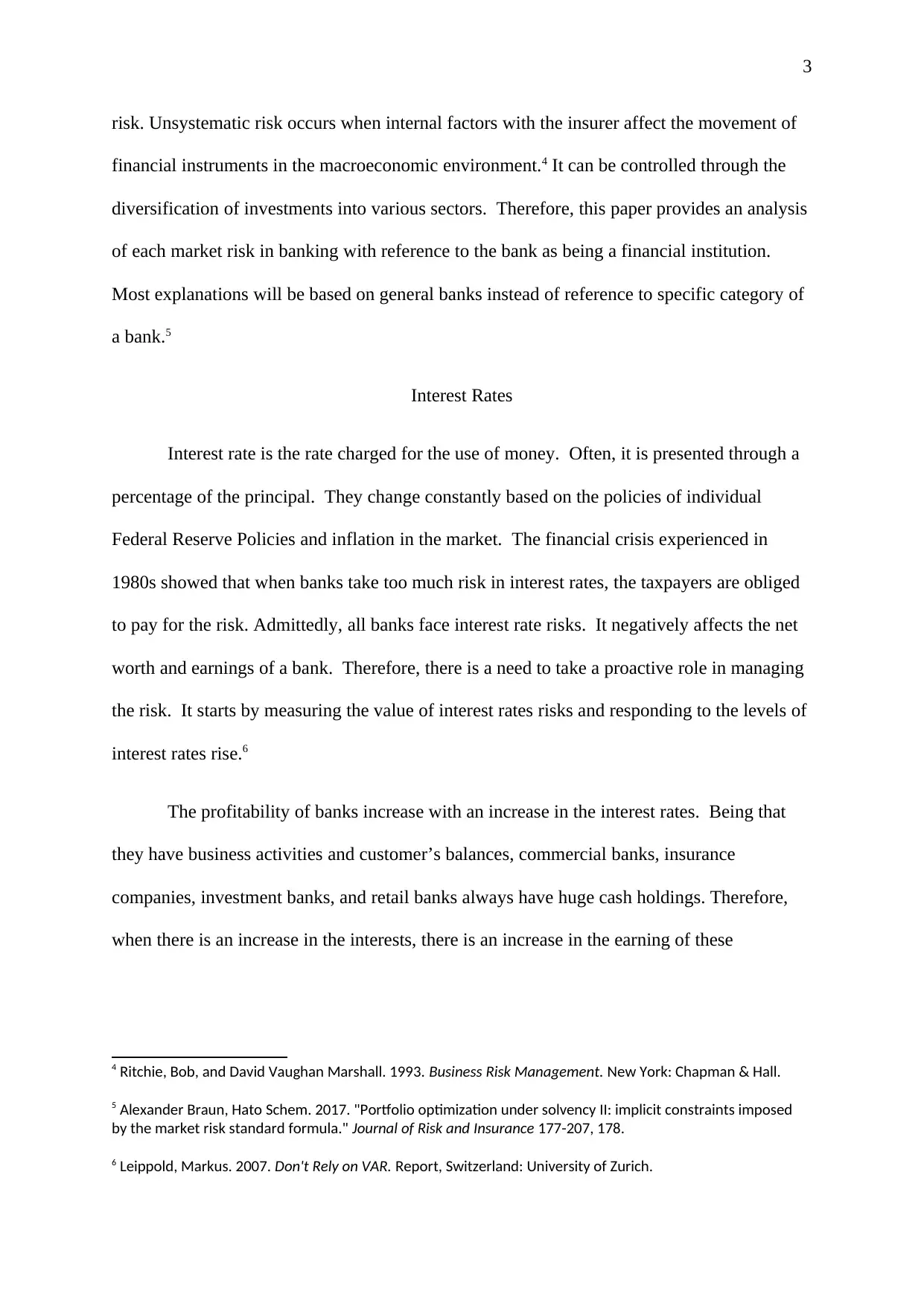
3
risk. Unsystematic risk occurs when internal factors with the insurer affect the movement of
financial instruments in the macroeconomic environment.4 It can be controlled through the
diversification of investments into various sectors. Therefore, this paper provides an analysis
of each market risk in banking with reference to the bank as being a financial institution.
Most explanations will be based on general banks instead of reference to specific category of
a bank.5
Interest Rates
Interest rate is the rate charged for the use of money. Often, it is presented through a
percentage of the principal. They change constantly based on the policies of individual
Federal Reserve Policies and inflation in the market. The financial crisis experienced in
1980s showed that when banks take too much risk in interest rates, the taxpayers are obliged
to pay for the risk. Admittedly, all banks face interest rate risks. It negatively affects the net
worth and earnings of a bank. Therefore, there is a need to take a proactive role in managing
the risk. It starts by measuring the value of interest rates risks and responding to the levels of
interest rates rise.6
The profitability of banks increase with an increase in the interest rates. Being that
they have business activities and customer’s balances, commercial banks, insurance
companies, investment banks, and retail banks always have huge cash holdings. Therefore,
when there is an increase in the interests, there is an increase in the earning of these
4 Ritchie, Bob, and David Vaughan Marshall. 1993. Business Risk Management. New York: Chapman & Hall.
5 Alexander Braun, Hato Schem. 2017. "Portfolio optimization under solvency II: implicit constraints imposed
by the market risk standard formula." Journal of Risk and Insurance 177-207, 178.
6 Leippold, Markus. 2007. Don't Rely on VAR. Report, Switzerland: University of Zurich.
risk. Unsystematic risk occurs when internal factors with the insurer affect the movement of
financial instruments in the macroeconomic environment.4 It can be controlled through the
diversification of investments into various sectors. Therefore, this paper provides an analysis
of each market risk in banking with reference to the bank as being a financial institution.
Most explanations will be based on general banks instead of reference to specific category of
a bank.5
Interest Rates
Interest rate is the rate charged for the use of money. Often, it is presented through a
percentage of the principal. They change constantly based on the policies of individual
Federal Reserve Policies and inflation in the market. The financial crisis experienced in
1980s showed that when banks take too much risk in interest rates, the taxpayers are obliged
to pay for the risk. Admittedly, all banks face interest rate risks. It negatively affects the net
worth and earnings of a bank. Therefore, there is a need to take a proactive role in managing
the risk. It starts by measuring the value of interest rates risks and responding to the levels of
interest rates rise.6
The profitability of banks increase with an increase in the interest rates. Being that
they have business activities and customer’s balances, commercial banks, insurance
companies, investment banks, and retail banks always have huge cash holdings. Therefore,
when there is an increase in the interests, there is an increase in the earning of these
4 Ritchie, Bob, and David Vaughan Marshall. 1993. Business Risk Management. New York: Chapman & Hall.
5 Alexander Braun, Hato Schem. 2017. "Portfolio optimization under solvency II: implicit constraints imposed
by the market risk standard formula." Journal of Risk and Insurance 177-207, 178.
6 Leippold, Markus. 2007. Don't Rely on VAR. Report, Switzerland: University of Zurich.
⊘ This is a preview!⊘
Do you want full access?
Subscribe today to unlock all pages.

Trusted by 1+ million students worldwide
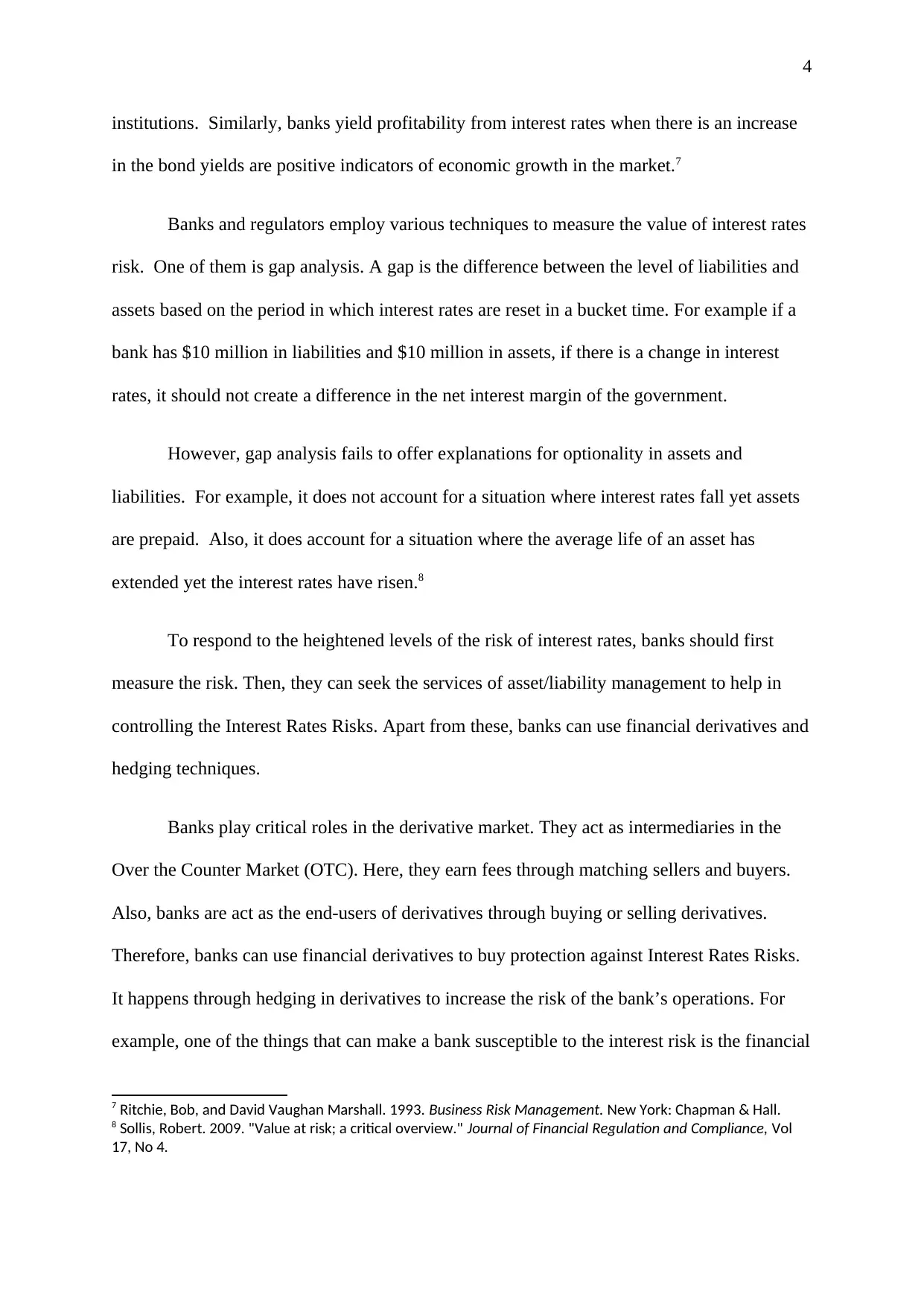
4
institutions. Similarly, banks yield profitability from interest rates when there is an increase
in the bond yields are positive indicators of economic growth in the market.7
Banks and regulators employ various techniques to measure the value of interest rates
risk. One of them is gap analysis. A gap is the difference between the level of liabilities and
assets based on the period in which interest rates are reset in a bucket time. For example if a
bank has $10 million in liabilities and $10 million in assets, if there is a change in interest
rates, it should not create a difference in the net interest margin of the government.
However, gap analysis fails to offer explanations for optionality in assets and
liabilities. For example, it does not account for a situation where interest rates fall yet assets
are prepaid. Also, it does account for a situation where the average life of an asset has
extended yet the interest rates have risen.8
To respond to the heightened levels of the risk of interest rates, banks should first
measure the risk. Then, they can seek the services of asset/liability management to help in
controlling the Interest Rates Risks. Apart from these, banks can use financial derivatives and
hedging techniques.
Banks play critical roles in the derivative market. They act as intermediaries in the
Over the Counter Market (OTC). Here, they earn fees through matching sellers and buyers.
Also, banks are act as the end-users of derivatives through buying or selling derivatives.
Therefore, banks can use financial derivatives to buy protection against Interest Rates Risks.
It happens through hedging in derivatives to increase the risk of the bank’s operations. For
example, one of the things that can make a bank susceptible to the interest risk is the financial
7 Ritchie, Bob, and David Vaughan Marshall. 1993. Business Risk Management. New York: Chapman & Hall.
8 Sollis, Robert. 2009. "Value at risk; a critical overview." Journal of Financial Regulation and Compliance, Vol
17, No 4.
institutions. Similarly, banks yield profitability from interest rates when there is an increase
in the bond yields are positive indicators of economic growth in the market.7
Banks and regulators employ various techniques to measure the value of interest rates
risk. One of them is gap analysis. A gap is the difference between the level of liabilities and
assets based on the period in which interest rates are reset in a bucket time. For example if a
bank has $10 million in liabilities and $10 million in assets, if there is a change in interest
rates, it should not create a difference in the net interest margin of the government.
However, gap analysis fails to offer explanations for optionality in assets and
liabilities. For example, it does not account for a situation where interest rates fall yet assets
are prepaid. Also, it does account for a situation where the average life of an asset has
extended yet the interest rates have risen.8
To respond to the heightened levels of the risk of interest rates, banks should first
measure the risk. Then, they can seek the services of asset/liability management to help in
controlling the Interest Rates Risks. Apart from these, banks can use financial derivatives and
hedging techniques.
Banks play critical roles in the derivative market. They act as intermediaries in the
Over the Counter Market (OTC). Here, they earn fees through matching sellers and buyers.
Also, banks are act as the end-users of derivatives through buying or selling derivatives.
Therefore, banks can use financial derivatives to buy protection against Interest Rates Risks.
It happens through hedging in derivatives to increase the risk of the bank’s operations. For
example, one of the things that can make a bank susceptible to the interest risk is the financial
7 Ritchie, Bob, and David Vaughan Marshall. 1993. Business Risk Management. New York: Chapman & Hall.
8 Sollis, Robert. 2009. "Value at risk; a critical overview." Journal of Financial Regulation and Compliance, Vol
17, No 4.
Paraphrase This Document
Need a fresh take? Get an instant paraphrase of this document with our AI Paraphraser
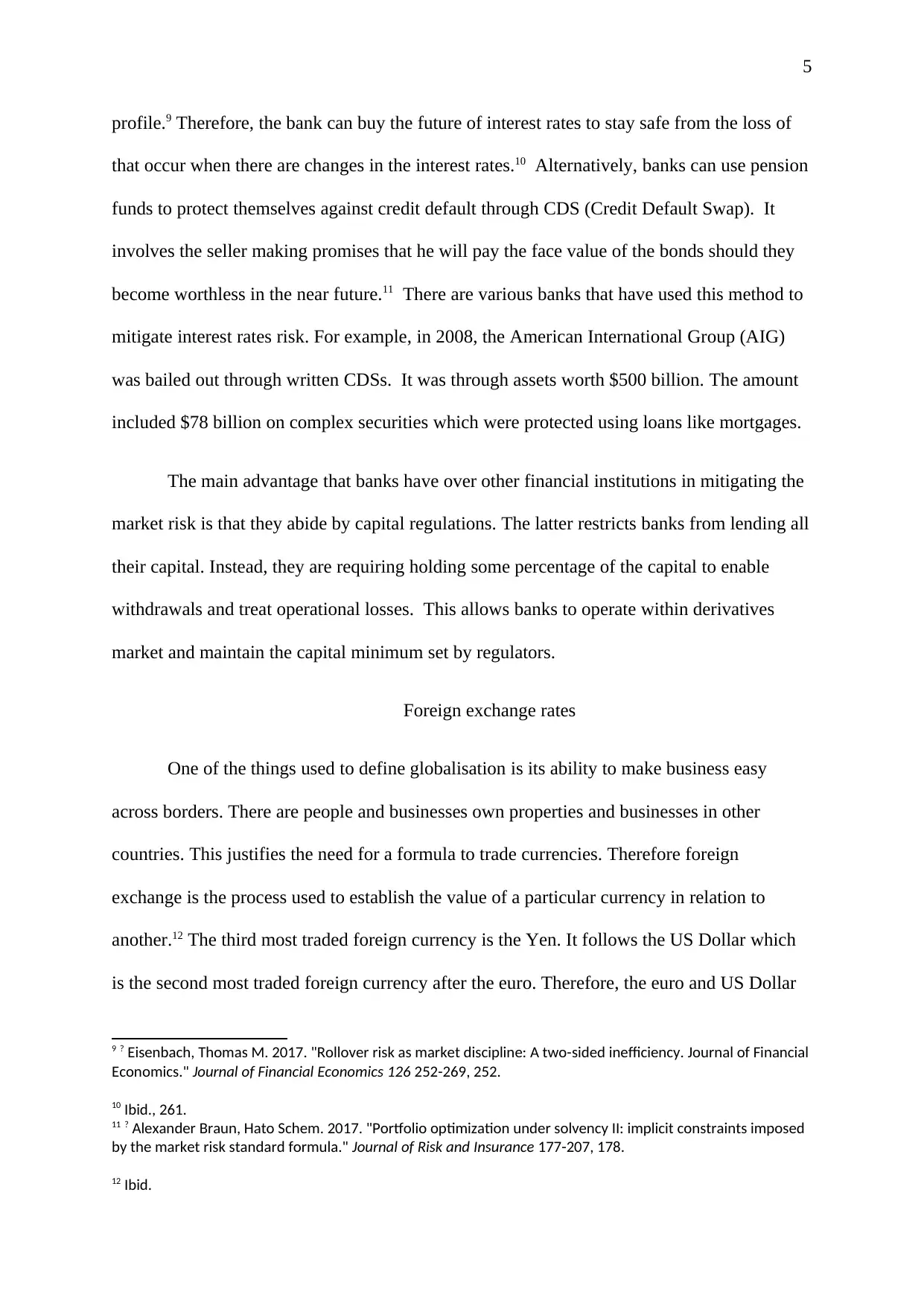
5
profile.9 Therefore, the bank can buy the future of interest rates to stay safe from the loss of
that occur when there are changes in the interest rates.10 Alternatively, banks can use pension
funds to protect themselves against credit default through CDS (Credit Default Swap). It
involves the seller making promises that he will pay the face value of the bonds should they
become worthless in the near future.11 There are various banks that have used this method to
mitigate interest rates risk. For example, in 2008, the American International Group (AIG)
was bailed out through written CDSs. It was through assets worth $500 billion. The amount
included $78 billion on complex securities which were protected using loans like mortgages.
The main advantage that banks have over other financial institutions in mitigating the
market risk is that they abide by capital regulations. The latter restricts banks from lending all
their capital. Instead, they are requiring holding some percentage of the capital to enable
withdrawals and treat operational losses. This allows banks to operate within derivatives
market and maintain the capital minimum set by regulators.
Foreign exchange rates
One of the things used to define globalisation is its ability to make business easy
across borders. There are people and businesses own properties and businesses in other
countries. This justifies the need for a formula to trade currencies. Therefore foreign
exchange is the process used to establish the value of a particular currency in relation to
another.12 The third most traded foreign currency is the Yen. It follows the US Dollar which
is the second most traded foreign currency after the euro. Therefore, the euro and US Dollar
9 ? Eisenbach, Thomas M. 2017. "Rollover risk as market discipline: A two-sided inefficiency. Journal of Financial
Economics." Journal of Financial Economics 126 252-269, 252.
10 Ibid., 261.
11 ? Alexander Braun, Hato Schem. 2017. "Portfolio optimization under solvency II: implicit constraints imposed
by the market risk standard formula." Journal of Risk and Insurance 177-207, 178.
12 Ibid.
profile.9 Therefore, the bank can buy the future of interest rates to stay safe from the loss of
that occur when there are changes in the interest rates.10 Alternatively, banks can use pension
funds to protect themselves against credit default through CDS (Credit Default Swap). It
involves the seller making promises that he will pay the face value of the bonds should they
become worthless in the near future.11 There are various banks that have used this method to
mitigate interest rates risk. For example, in 2008, the American International Group (AIG)
was bailed out through written CDSs. It was through assets worth $500 billion. The amount
included $78 billion on complex securities which were protected using loans like mortgages.
The main advantage that banks have over other financial institutions in mitigating the
market risk is that they abide by capital regulations. The latter restricts banks from lending all
their capital. Instead, they are requiring holding some percentage of the capital to enable
withdrawals and treat operational losses. This allows banks to operate within derivatives
market and maintain the capital minimum set by regulators.
Foreign exchange rates
One of the things used to define globalisation is its ability to make business easy
across borders. There are people and businesses own properties and businesses in other
countries. This justifies the need for a formula to trade currencies. Therefore foreign
exchange is the process used to establish the value of a particular currency in relation to
another.12 The third most traded foreign currency is the Yen. It follows the US Dollar which
is the second most traded foreign currency after the euro. Therefore, the euro and US Dollar
9 ? Eisenbach, Thomas M. 2017. "Rollover risk as market discipline: A two-sided inefficiency. Journal of Financial
Economics." Journal of Financial Economics 126 252-269, 252.
10 Ibid., 261.
11 ? Alexander Braun, Hato Schem. 2017. "Portfolio optimization under solvency II: implicit constraints imposed
by the market risk standard formula." Journal of Risk and Insurance 177-207, 178.
12 Ibid.
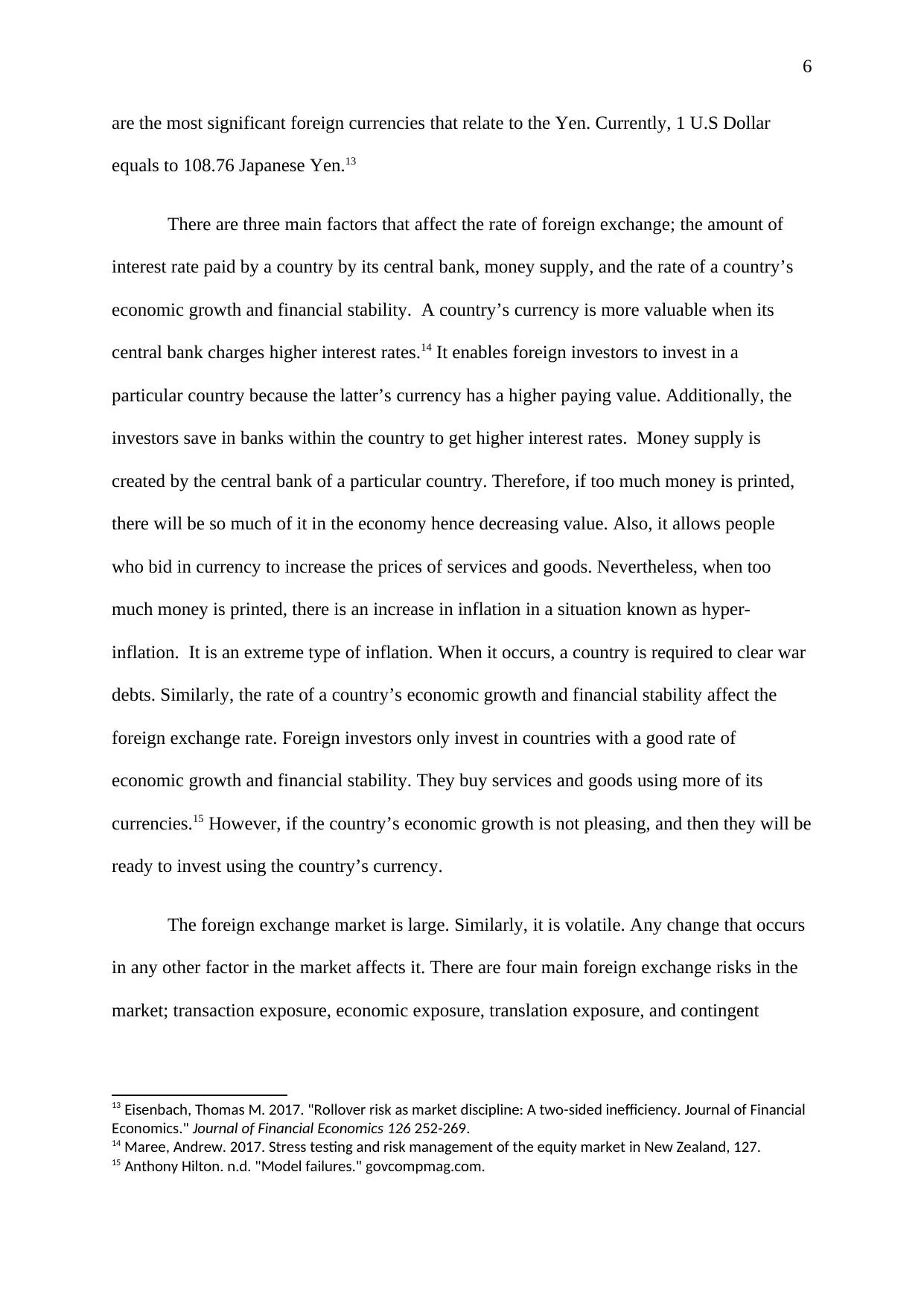
6
are the most significant foreign currencies that relate to the Yen. Currently, 1 U.S Dollar
equals to 108.76 Japanese Yen.13
There are three main factors that affect the rate of foreign exchange; the amount of
interest rate paid by a country by its central bank, money supply, and the rate of a country’s
economic growth and financial stability. A country’s currency is more valuable when its
central bank charges higher interest rates.14 It enables foreign investors to invest in a
particular country because the latter’s currency has a higher paying value. Additionally, the
investors save in banks within the country to get higher interest rates. Money supply is
created by the central bank of a particular country. Therefore, if too much money is printed,
there will be so much of it in the economy hence decreasing value. Also, it allows people
who bid in currency to increase the prices of services and goods. Nevertheless, when too
much money is printed, there is an increase in inflation in a situation known as hyper-
inflation. It is an extreme type of inflation. When it occurs, a country is required to clear war
debts. Similarly, the rate of a country’s economic growth and financial stability affect the
foreign exchange rate. Foreign investors only invest in countries with a good rate of
economic growth and financial stability. They buy services and goods using more of its
currencies.15 However, if the country’s economic growth is not pleasing, and then they will be
ready to invest using the country’s currency.
The foreign exchange market is large. Similarly, it is volatile. Any change that occurs
in any other factor in the market affects it. There are four main foreign exchange risks in the
market; transaction exposure, economic exposure, translation exposure, and contingent
13 Eisenbach, Thomas M. 2017. "Rollover risk as market discipline: A two-sided inefficiency. Journal of Financial
Economics." Journal of Financial Economics 126 252-269.
14 Maree, Andrew. 2017. Stress testing and risk management of the equity market in New Zealand, 127.
15 Anthony Hilton. n.d. "Model failures." govcompmag.com.
are the most significant foreign currencies that relate to the Yen. Currently, 1 U.S Dollar
equals to 108.76 Japanese Yen.13
There are three main factors that affect the rate of foreign exchange; the amount of
interest rate paid by a country by its central bank, money supply, and the rate of a country’s
economic growth and financial stability. A country’s currency is more valuable when its
central bank charges higher interest rates.14 It enables foreign investors to invest in a
particular country because the latter’s currency has a higher paying value. Additionally, the
investors save in banks within the country to get higher interest rates. Money supply is
created by the central bank of a particular country. Therefore, if too much money is printed,
there will be so much of it in the economy hence decreasing value. Also, it allows people
who bid in currency to increase the prices of services and goods. Nevertheless, when too
much money is printed, there is an increase in inflation in a situation known as hyper-
inflation. It is an extreme type of inflation. When it occurs, a country is required to clear war
debts. Similarly, the rate of a country’s economic growth and financial stability affect the
foreign exchange rate. Foreign investors only invest in countries with a good rate of
economic growth and financial stability. They buy services and goods using more of its
currencies.15 However, if the country’s economic growth is not pleasing, and then they will be
ready to invest using the country’s currency.
The foreign exchange market is large. Similarly, it is volatile. Any change that occurs
in any other factor in the market affects it. There are four main foreign exchange risks in the
market; transaction exposure, economic exposure, translation exposure, and contingent
13 Eisenbach, Thomas M. 2017. "Rollover risk as market discipline: A two-sided inefficiency. Journal of Financial
Economics." Journal of Financial Economics 126 252-269.
14 Maree, Andrew. 2017. Stress testing and risk management of the equity market in New Zealand, 127.
15 Anthony Hilton. n.d. "Model failures." govcompmag.com.
⊘ This is a preview!⊘
Do you want full access?
Subscribe today to unlock all pages.

Trusted by 1+ million students worldwide
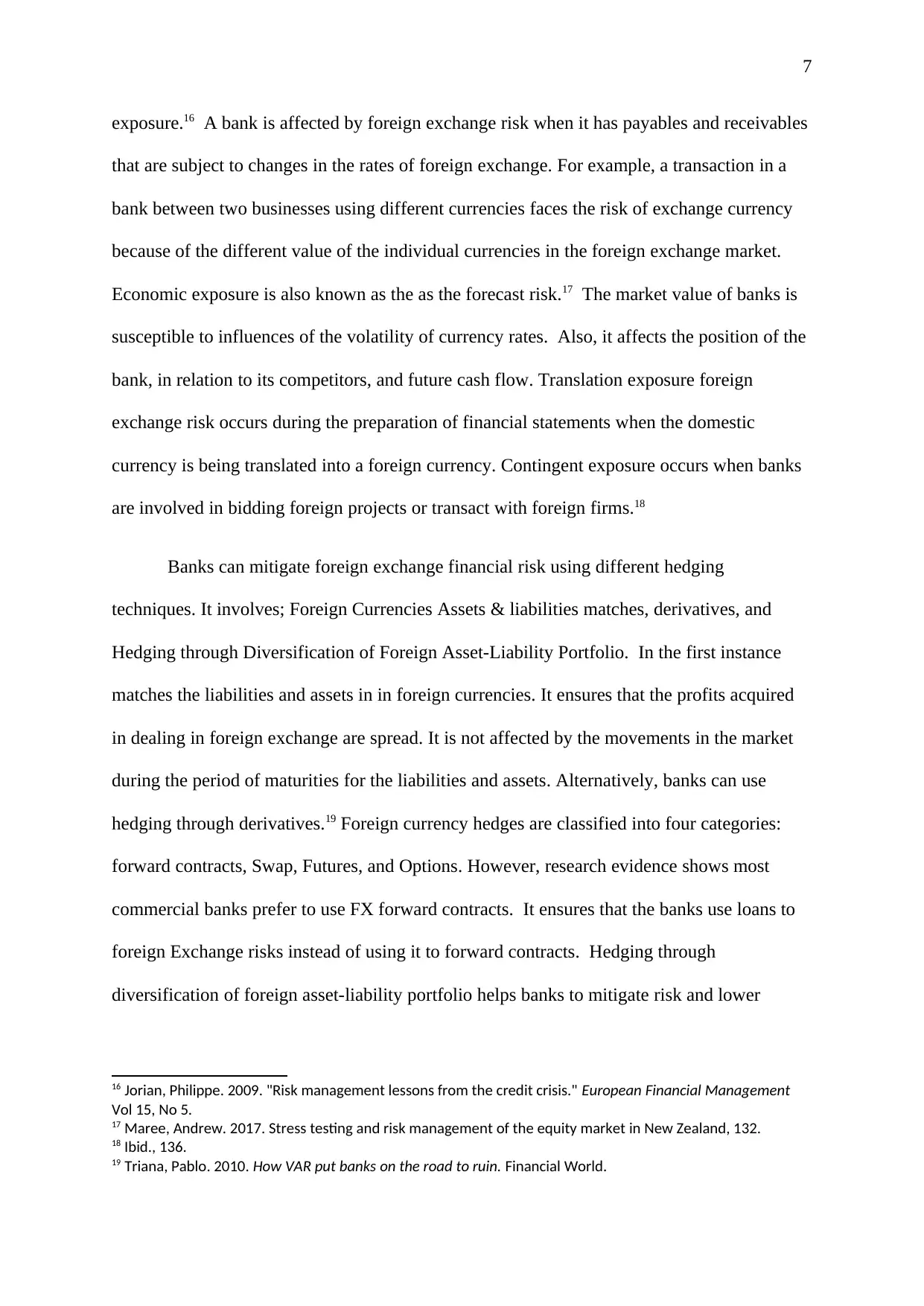
7
exposure.16 A bank is affected by foreign exchange risk when it has payables and receivables
that are subject to changes in the rates of foreign exchange. For example, a transaction in a
bank between two businesses using different currencies faces the risk of exchange currency
because of the different value of the individual currencies in the foreign exchange market.
Economic exposure is also known as the as the forecast risk.17 The market value of banks is
susceptible to influences of the volatility of currency rates. Also, it affects the position of the
bank, in relation to its competitors, and future cash flow. Translation exposure foreign
exchange risk occurs during the preparation of financial statements when the domestic
currency is being translated into a foreign currency. Contingent exposure occurs when banks
are involved in bidding foreign projects or transact with foreign firms.18
Banks can mitigate foreign exchange financial risk using different hedging
techniques. It involves; Foreign Currencies Assets & liabilities matches, derivatives, and
Hedging through Diversification of Foreign Asset-Liability Portfolio. In the first instance
matches the liabilities and assets in in foreign currencies. It ensures that the profits acquired
in dealing in foreign exchange are spread. It is not affected by the movements in the market
during the period of maturities for the liabilities and assets. Alternatively, banks can use
hedging through derivatives.19 Foreign currency hedges are classified into four categories:
forward contracts, Swap, Futures, and Options. However, research evidence shows most
commercial banks prefer to use FX forward contracts. It ensures that the banks use loans to
foreign Exchange risks instead of using it to forward contracts. Hedging through
diversification of foreign asset-liability portfolio helps banks to mitigate risk and lower
16 Jorian, Philippe. 2009. "Risk management lessons from the credit crisis." European Financial Management
Vol 15, No 5.
17 Maree, Andrew. 2017. Stress testing and risk management of the equity market in New Zealand, 132.
18 Ibid., 136.
19 Triana, Pablo. 2010. How VAR put banks on the road to ruin. Financial World.
exposure.16 A bank is affected by foreign exchange risk when it has payables and receivables
that are subject to changes in the rates of foreign exchange. For example, a transaction in a
bank between two businesses using different currencies faces the risk of exchange currency
because of the different value of the individual currencies in the foreign exchange market.
Economic exposure is also known as the as the forecast risk.17 The market value of banks is
susceptible to influences of the volatility of currency rates. Also, it affects the position of the
bank, in relation to its competitors, and future cash flow. Translation exposure foreign
exchange risk occurs during the preparation of financial statements when the domestic
currency is being translated into a foreign currency. Contingent exposure occurs when banks
are involved in bidding foreign projects or transact with foreign firms.18
Banks can mitigate foreign exchange financial risk using different hedging
techniques. It involves; Foreign Currencies Assets & liabilities matches, derivatives, and
Hedging through Diversification of Foreign Asset-Liability Portfolio. In the first instance
matches the liabilities and assets in in foreign currencies. It ensures that the profits acquired
in dealing in foreign exchange are spread. It is not affected by the movements in the market
during the period of maturities for the liabilities and assets. Alternatively, banks can use
hedging through derivatives.19 Foreign currency hedges are classified into four categories:
forward contracts, Swap, Futures, and Options. However, research evidence shows most
commercial banks prefer to use FX forward contracts. It ensures that the banks use loans to
foreign Exchange risks instead of using it to forward contracts. Hedging through
diversification of foreign asset-liability portfolio helps banks to mitigate risk and lower
16 Jorian, Philippe. 2009. "Risk management lessons from the credit crisis." European Financial Management
Vol 15, No 5.
17 Maree, Andrew. 2017. Stress testing and risk management of the equity market in New Zealand, 132.
18 Ibid., 136.
19 Triana, Pablo. 2010. How VAR put banks on the road to ruin. Financial World.
Paraphrase This Document
Need a fresh take? Get an instant paraphrase of this document with our AI Paraphraser
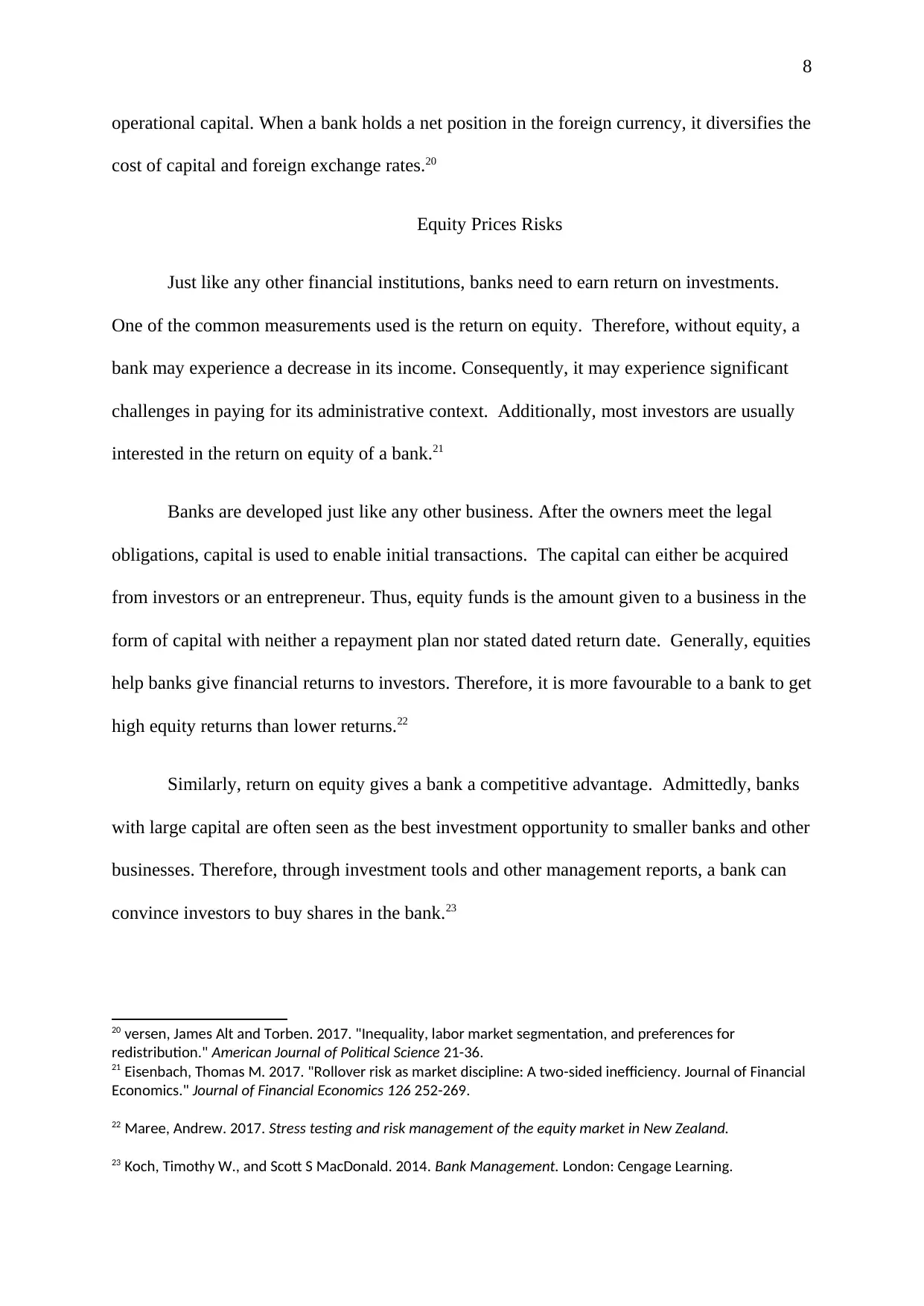
8
operational capital. When a bank holds a net position in the foreign currency, it diversifies the
cost of capital and foreign exchange rates.20
Equity Prices Risks
Just like any other financial institutions, banks need to earn return on investments.
One of the common measurements used is the return on equity. Therefore, without equity, a
bank may experience a decrease in its income. Consequently, it may experience significant
challenges in paying for its administrative context. Additionally, most investors are usually
interested in the return on equity of a bank.21
Banks are developed just like any other business. After the owners meet the legal
obligations, capital is used to enable initial transactions. The capital can either be acquired
from investors or an entrepreneur. Thus, equity funds is the amount given to a business in the
form of capital with neither a repayment plan nor stated dated return date. Generally, equities
help banks give financial returns to investors. Therefore, it is more favourable to a bank to get
high equity returns than lower returns.22
Similarly, return on equity gives a bank a competitive advantage. Admittedly, banks
with large capital are often seen as the best investment opportunity to smaller banks and other
businesses. Therefore, through investment tools and other management reports, a bank can
convince investors to buy shares in the bank.23
20 versen, James Alt and Torben. 2017. "Inequality, labor market segmentation, and preferences for
redistribution." American Journal of Political Science 21-36.
21 Eisenbach, Thomas M. 2017. "Rollover risk as market discipline: A two-sided inefficiency. Journal of Financial
Economics." Journal of Financial Economics 126 252-269.
22 Maree, Andrew. 2017. Stress testing and risk management of the equity market in New Zealand.
23 Koch, Timothy W., and Scott S MacDonald. 2014. Bank Management. London: Cengage Learning.
operational capital. When a bank holds a net position in the foreign currency, it diversifies the
cost of capital and foreign exchange rates.20
Equity Prices Risks
Just like any other financial institutions, banks need to earn return on investments.
One of the common measurements used is the return on equity. Therefore, without equity, a
bank may experience a decrease in its income. Consequently, it may experience significant
challenges in paying for its administrative context. Additionally, most investors are usually
interested in the return on equity of a bank.21
Banks are developed just like any other business. After the owners meet the legal
obligations, capital is used to enable initial transactions. The capital can either be acquired
from investors or an entrepreneur. Thus, equity funds is the amount given to a business in the
form of capital with neither a repayment plan nor stated dated return date. Generally, equities
help banks give financial returns to investors. Therefore, it is more favourable to a bank to get
high equity returns than lower returns.22
Similarly, return on equity gives a bank a competitive advantage. Admittedly, banks
with large capital are often seen as the best investment opportunity to smaller banks and other
businesses. Therefore, through investment tools and other management reports, a bank can
convince investors to buy shares in the bank.23
20 versen, James Alt and Torben. 2017. "Inequality, labor market segmentation, and preferences for
redistribution." American Journal of Political Science 21-36.
21 Eisenbach, Thomas M. 2017. "Rollover risk as market discipline: A two-sided inefficiency. Journal of Financial
Economics." Journal of Financial Economics 126 252-269.
22 Maree, Andrew. 2017. Stress testing and risk management of the equity market in New Zealand.
23 Koch, Timothy W., and Scott S MacDonald. 2014. Bank Management. London: Cengage Learning.
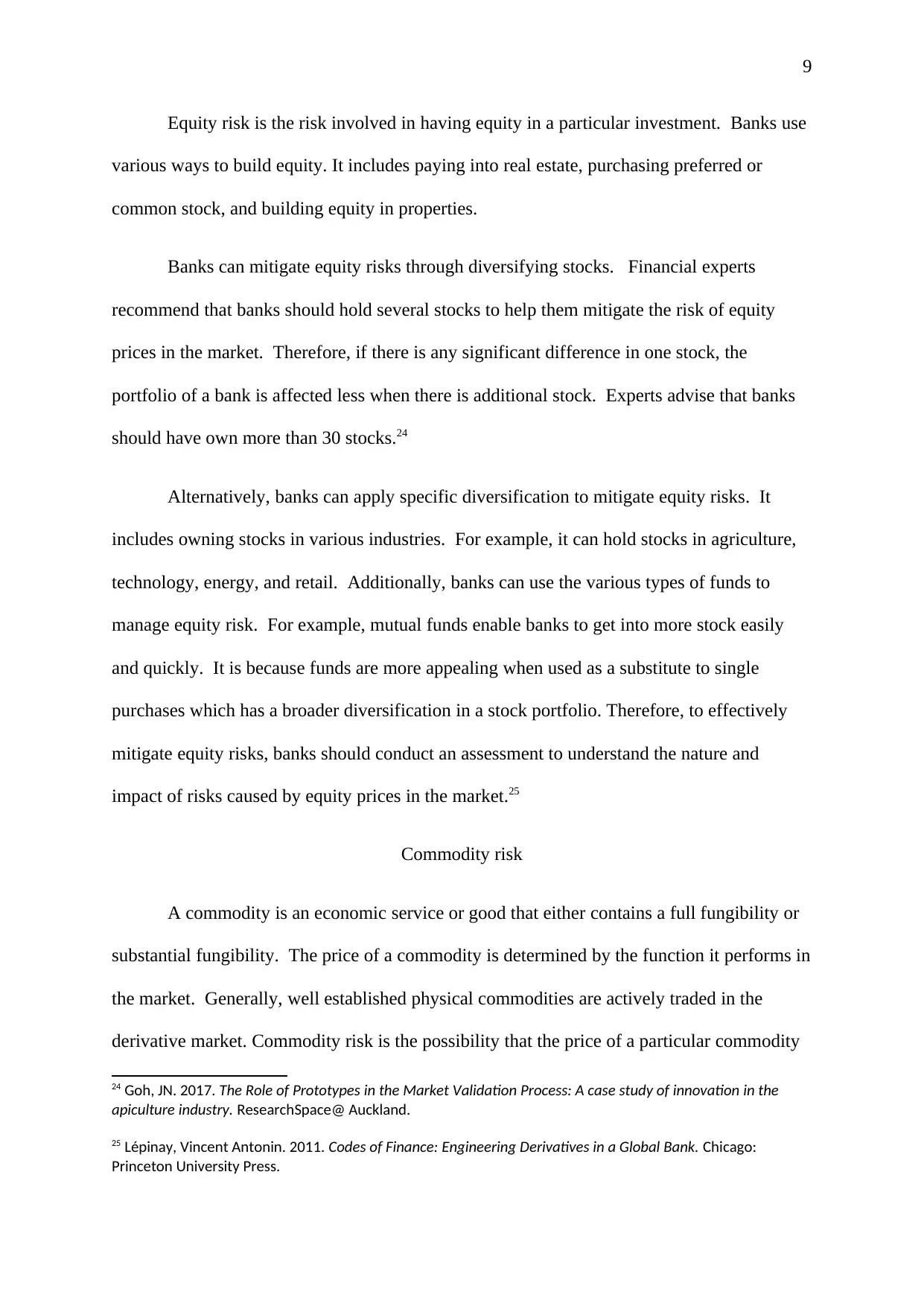
9
Equity risk is the risk involved in having equity in a particular investment. Banks use
various ways to build equity. It includes paying into real estate, purchasing preferred or
common stock, and building equity in properties.
Banks can mitigate equity risks through diversifying stocks. Financial experts
recommend that banks should hold several stocks to help them mitigate the risk of equity
prices in the market. Therefore, if there is any significant difference in one stock, the
portfolio of a bank is affected less when there is additional stock. Experts advise that banks
should have own more than 30 stocks.24
Alternatively, banks can apply specific diversification to mitigate equity risks. It
includes owning stocks in various industries. For example, it can hold stocks in agriculture,
technology, energy, and retail. Additionally, banks can use the various types of funds to
manage equity risk. For example, mutual funds enable banks to get into more stock easily
and quickly. It is because funds are more appealing when used as a substitute to single
purchases which has a broader diversification in a stock portfolio. Therefore, to effectively
mitigate equity risks, banks should conduct an assessment to understand the nature and
impact of risks caused by equity prices in the market.25
Commodity risk
A commodity is an economic service or good that either contains a full fungibility or
substantial fungibility. The price of a commodity is determined by the function it performs in
the market. Generally, well established physical commodities are actively traded in the
derivative market. Commodity risk is the possibility that the price of a particular commodity
24 Goh, JN. 2017. The Role of Prototypes in the Market Validation Process: A case study of innovation in the
apiculture industry. ResearchSpace@ Auckland.
25 Lépinay, Vincent Antonin. 2011. Codes of Finance: Engineering Derivatives in a Global Bank. Chicago:
Princeton University Press.
Equity risk is the risk involved in having equity in a particular investment. Banks use
various ways to build equity. It includes paying into real estate, purchasing preferred or
common stock, and building equity in properties.
Banks can mitigate equity risks through diversifying stocks. Financial experts
recommend that banks should hold several stocks to help them mitigate the risk of equity
prices in the market. Therefore, if there is any significant difference in one stock, the
portfolio of a bank is affected less when there is additional stock. Experts advise that banks
should have own more than 30 stocks.24
Alternatively, banks can apply specific diversification to mitigate equity risks. It
includes owning stocks in various industries. For example, it can hold stocks in agriculture,
technology, energy, and retail. Additionally, banks can use the various types of funds to
manage equity risk. For example, mutual funds enable banks to get into more stock easily
and quickly. It is because funds are more appealing when used as a substitute to single
purchases which has a broader diversification in a stock portfolio. Therefore, to effectively
mitigate equity risks, banks should conduct an assessment to understand the nature and
impact of risks caused by equity prices in the market.25
Commodity risk
A commodity is an economic service or good that either contains a full fungibility or
substantial fungibility. The price of a commodity is determined by the function it performs in
the market. Generally, well established physical commodities are actively traded in the
derivative market. Commodity risk is the possibility that the price of a particular commodity
24 Goh, JN. 2017. The Role of Prototypes in the Market Validation Process: A case study of innovation in the
apiculture industry. ResearchSpace@ Auckland.
25 Lépinay, Vincent Antonin. 2011. Codes of Finance: Engineering Derivatives in a Global Bank. Chicago:
Princeton University Press.
⊘ This is a preview!⊘
Do you want full access?
Subscribe today to unlock all pages.

Trusted by 1+ million students worldwide
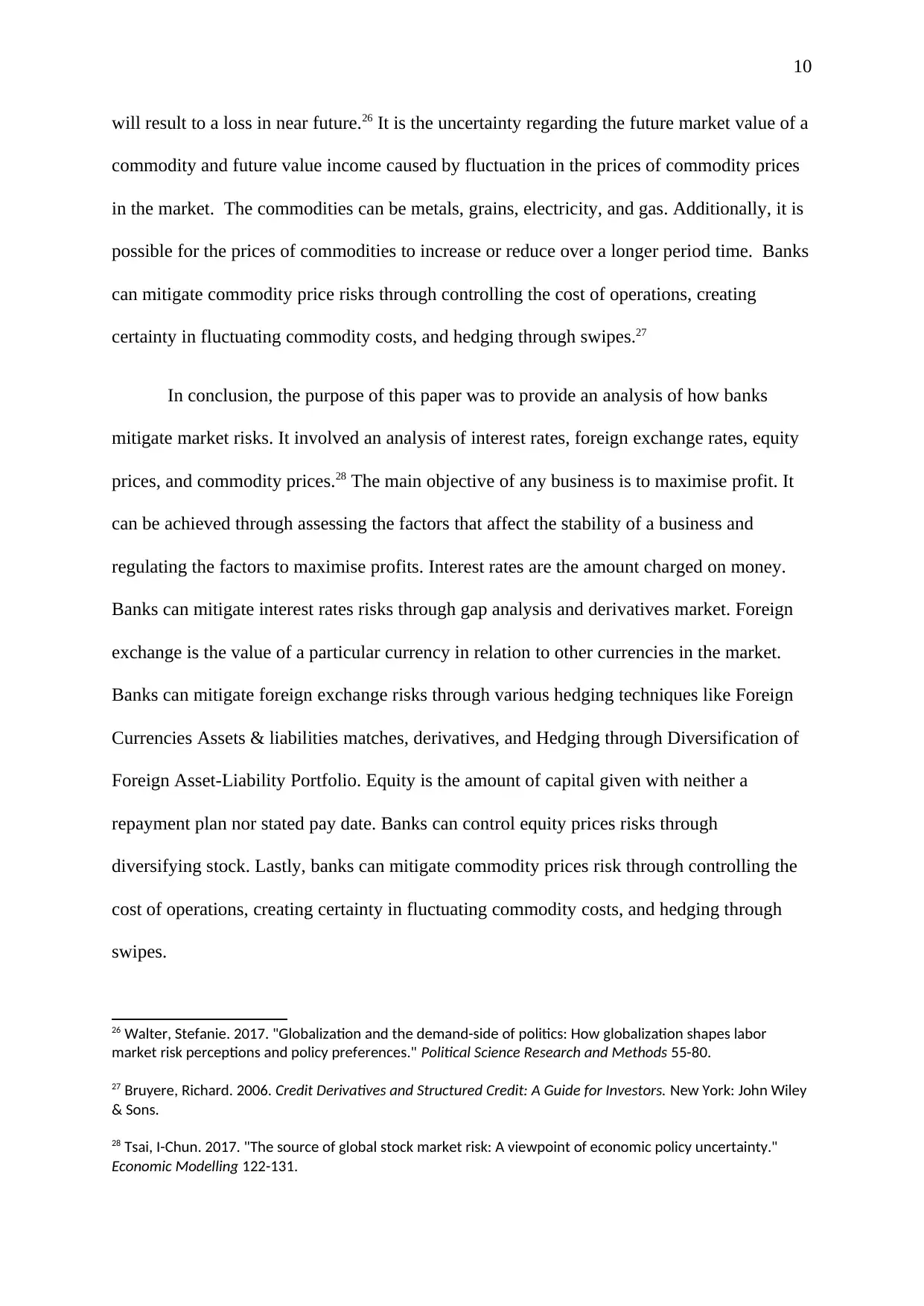
10
will result to a loss in near future.26 It is the uncertainty regarding the future market value of a
commodity and future value income caused by fluctuation in the prices of commodity prices
in the market. The commodities can be metals, grains, electricity, and gas. Additionally, it is
possible for the prices of commodities to increase or reduce over a longer period time. Banks
can mitigate commodity price risks through controlling the cost of operations, creating
certainty in fluctuating commodity costs, and hedging through swipes.27
In conclusion, the purpose of this paper was to provide an analysis of how banks
mitigate market risks. It involved an analysis of interest rates, foreign exchange rates, equity
prices, and commodity prices.28 The main objective of any business is to maximise profit. It
can be achieved through assessing the factors that affect the stability of a business and
regulating the factors to maximise profits. Interest rates are the amount charged on money.
Banks can mitigate interest rates risks through gap analysis and derivatives market. Foreign
exchange is the value of a particular currency in relation to other currencies in the market.
Banks can mitigate foreign exchange risks through various hedging techniques like Foreign
Currencies Assets & liabilities matches, derivatives, and Hedging through Diversification of
Foreign Asset-Liability Portfolio. Equity is the amount of capital given with neither a
repayment plan nor stated pay date. Banks can control equity prices risks through
diversifying stock. Lastly, banks can mitigate commodity prices risk through controlling the
cost of operations, creating certainty in fluctuating commodity costs, and hedging through
swipes.
26 Walter, Stefanie. 2017. "Globalization and the demand-side of politics: How globalization shapes labor
market risk perceptions and policy preferences." Political Science Research and Methods 55-80.
27 Bruyere, Richard. 2006. Credit Derivatives and Structured Credit: A Guide for Investors. New York: John Wiley
& Sons.
28 Tsai, I-Chun. 2017. "The source of global stock market risk: A viewpoint of economic policy uncertainty."
Economic Modelling 122-131.
will result to a loss in near future.26 It is the uncertainty regarding the future market value of a
commodity and future value income caused by fluctuation in the prices of commodity prices
in the market. The commodities can be metals, grains, electricity, and gas. Additionally, it is
possible for the prices of commodities to increase or reduce over a longer period time. Banks
can mitigate commodity price risks through controlling the cost of operations, creating
certainty in fluctuating commodity costs, and hedging through swipes.27
In conclusion, the purpose of this paper was to provide an analysis of how banks
mitigate market risks. It involved an analysis of interest rates, foreign exchange rates, equity
prices, and commodity prices.28 The main objective of any business is to maximise profit. It
can be achieved through assessing the factors that affect the stability of a business and
regulating the factors to maximise profits. Interest rates are the amount charged on money.
Banks can mitigate interest rates risks through gap analysis and derivatives market. Foreign
exchange is the value of a particular currency in relation to other currencies in the market.
Banks can mitigate foreign exchange risks through various hedging techniques like Foreign
Currencies Assets & liabilities matches, derivatives, and Hedging through Diversification of
Foreign Asset-Liability Portfolio. Equity is the amount of capital given with neither a
repayment plan nor stated pay date. Banks can control equity prices risks through
diversifying stock. Lastly, banks can mitigate commodity prices risk through controlling the
cost of operations, creating certainty in fluctuating commodity costs, and hedging through
swipes.
26 Walter, Stefanie. 2017. "Globalization and the demand-side of politics: How globalization shapes labor
market risk perceptions and policy preferences." Political Science Research and Methods 55-80.
27 Bruyere, Richard. 2006. Credit Derivatives and Structured Credit: A Guide for Investors. New York: John Wiley
& Sons.
28 Tsai, I-Chun. 2017. "The source of global stock market risk: A viewpoint of economic policy uncertainty."
Economic Modelling 122-131.
Paraphrase This Document
Need a fresh take? Get an instant paraphrase of this document with our AI Paraphraser
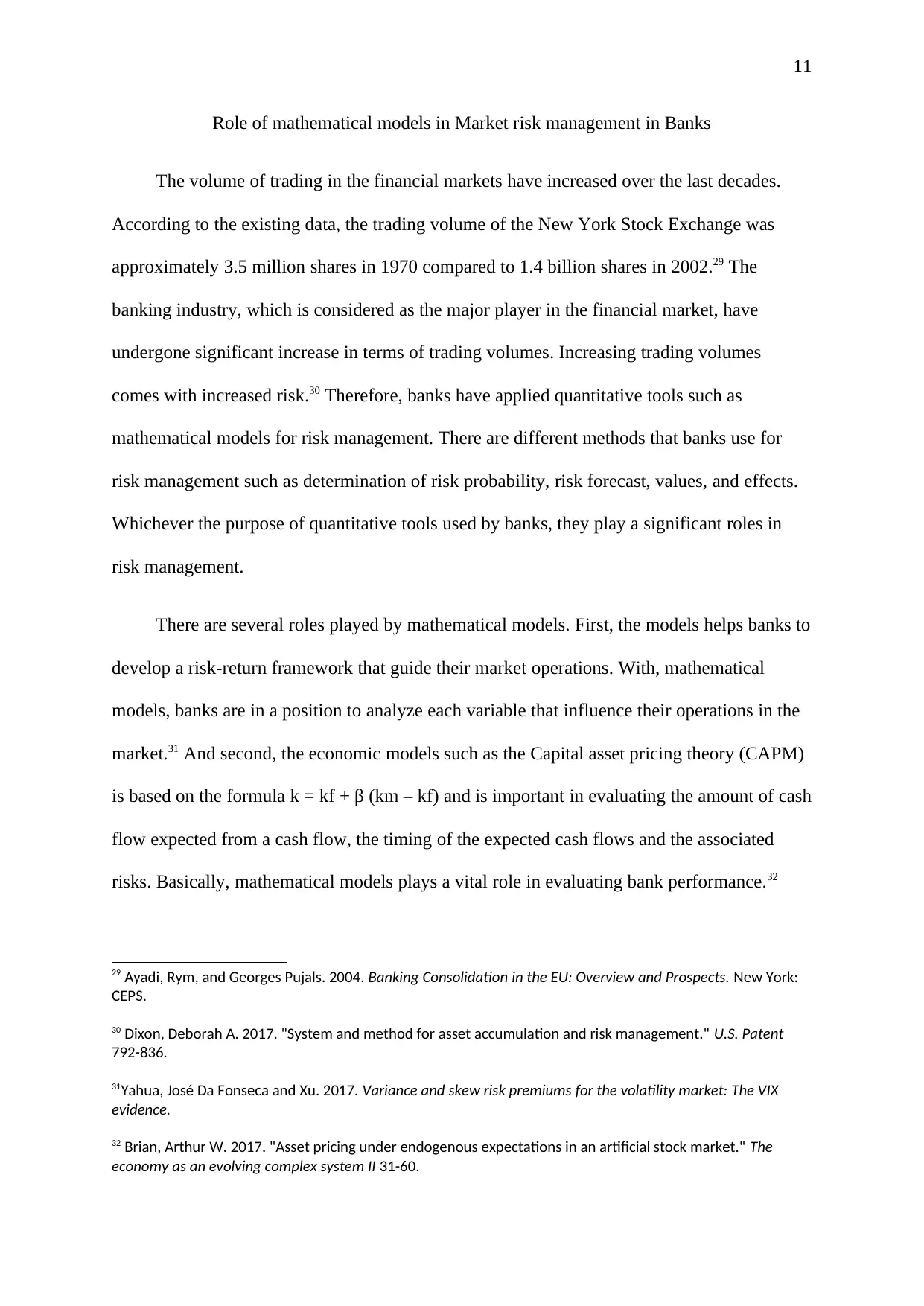
11
Role of mathematical models in Market risk management in Banks
The volume of trading in the financial markets have increased over the last decades.
According to the existing data, the trading volume of the New York Stock Exchange was
approximately 3.5 million shares in 1970 compared to 1.4 billion shares in 2002.29 The
banking industry, which is considered as the major player in the financial market, have
undergone significant increase in terms of trading volumes. Increasing trading volumes
comes with increased risk.30 Therefore, banks have applied quantitative tools such as
mathematical models for risk management. There are different methods that banks use for
risk management such as determination of risk probability, risk forecast, values, and effects.
Whichever the purpose of quantitative tools used by banks, they play a significant roles in
risk management.
There are several roles played by mathematical models. First, the models helps banks to
develop a risk-return framework that guide their market operations. With, mathematical
models, banks are in a position to analyze each variable that influence their operations in the
market.31 And second, the economic models such as the Capital asset pricing theory (CAPM)
is based on the formula k = kf + β (km – kf) and is important in evaluating the amount of cash
flow expected from a cash flow, the timing of the expected cash flows and the associated
risks. Basically, mathematical models plays a vital role in evaluating bank performance.32
29 Ayadi, Rym, and Georges Pujals. 2004. Banking Consolidation in the EU: Overview and Prospects. New York:
CEPS.
30 Dixon, Deborah A. 2017. "System and method for asset accumulation and risk management." U.S. Patent
792-836.
31Yahua, José Da Fonseca and Xu. 2017. Variance and skew risk premiums for the volatility market: The VIX
evidence.
32 Brian, Arthur W. 2017. "Asset pricing under endogenous expectations in an artificial stock market." The
economy as an evolving complex system II 31-60.
Role of mathematical models in Market risk management in Banks
The volume of trading in the financial markets have increased over the last decades.
According to the existing data, the trading volume of the New York Stock Exchange was
approximately 3.5 million shares in 1970 compared to 1.4 billion shares in 2002.29 The
banking industry, which is considered as the major player in the financial market, have
undergone significant increase in terms of trading volumes. Increasing trading volumes
comes with increased risk.30 Therefore, banks have applied quantitative tools such as
mathematical models for risk management. There are different methods that banks use for
risk management such as determination of risk probability, risk forecast, values, and effects.
Whichever the purpose of quantitative tools used by banks, they play a significant roles in
risk management.
There are several roles played by mathematical models. First, the models helps banks to
develop a risk-return framework that guide their market operations. With, mathematical
models, banks are in a position to analyze each variable that influence their operations in the
market.31 And second, the economic models such as the Capital asset pricing theory (CAPM)
is based on the formula k = kf + β (km – kf) and is important in evaluating the amount of cash
flow expected from a cash flow, the timing of the expected cash flows and the associated
risks. Basically, mathematical models plays a vital role in evaluating bank performance.32
29 Ayadi, Rym, and Georges Pujals. 2004. Banking Consolidation in the EU: Overview and Prospects. New York:
CEPS.
30 Dixon, Deborah A. 2017. "System and method for asset accumulation and risk management." U.S. Patent
792-836.
31Yahua, José Da Fonseca and Xu. 2017. Variance and skew risk premiums for the volatility market: The VIX
evidence.
32 Brian, Arthur W. 2017. "Asset pricing under endogenous expectations in an artificial stock market." The
economy as an evolving complex system II 31-60.
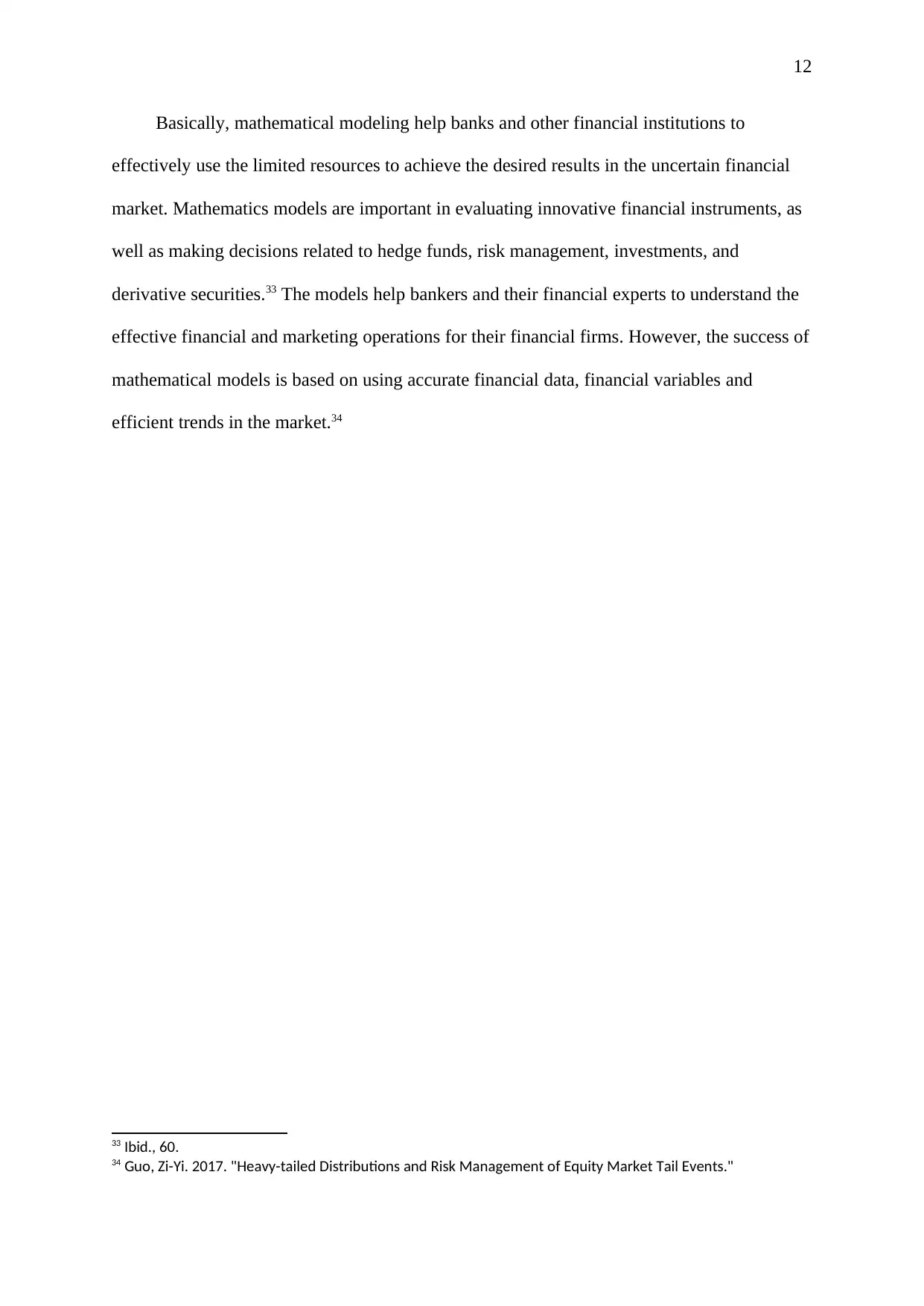
12
Basically, mathematical modeling help banks and other financial institutions to
effectively use the limited resources to achieve the desired results in the uncertain financial
market. Mathematics models are important in evaluating innovative financial instruments, as
well as making decisions related to hedge funds, risk management, investments, and
derivative securities.33 The models help bankers and their financial experts to understand the
effective financial and marketing operations for their financial firms. However, the success of
mathematical models is based on using accurate financial data, financial variables and
efficient trends in the market.34
33 Ibid., 60.
34 Guo, Zi-Yi. 2017. "Heavy-tailed Distributions and Risk Management of Equity Market Tail Events."
Basically, mathematical modeling help banks and other financial institutions to
effectively use the limited resources to achieve the desired results in the uncertain financial
market. Mathematics models are important in evaluating innovative financial instruments, as
well as making decisions related to hedge funds, risk management, investments, and
derivative securities.33 The models help bankers and their financial experts to understand the
effective financial and marketing operations for their financial firms. However, the success of
mathematical models is based on using accurate financial data, financial variables and
efficient trends in the market.34
33 Ibid., 60.
34 Guo, Zi-Yi. 2017. "Heavy-tailed Distributions and Risk Management of Equity Market Tail Events."
⊘ This is a preview!⊘
Do you want full access?
Subscribe today to unlock all pages.

Trusted by 1+ million students worldwide
1 out of 14
Related Documents
Your All-in-One AI-Powered Toolkit for Academic Success.
+13062052269
info@desklib.com
Available 24*7 on WhatsApp / Email
![[object Object]](/_next/static/media/star-bottom.7253800d.svg)
Unlock your academic potential
Copyright © 2020–2025 A2Z Services. All Rights Reserved. Developed and managed by ZUCOL.





